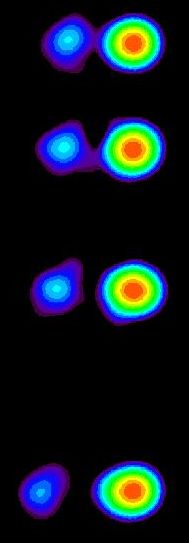In Blazing Speed: The Fastest Stuff in the Universe, Robert Roy Britt looks at recent studies of a form of matter that moves remarkably close to the speed of light. The material comes in the form of huge jets of hot gas that are ejected from a kind of galaxy called a blazar. Some of these jets attain speeds of 99.9 percent of the speed of light, according to a study presented at the recent AAS meeting by Glenn Piner of Whittier College in Whittier, California. Britt’s article gives an overview of Piner’s work, but dig deeper at Piner’s Web site Quasar Research at Whittier College, where he explains the study’s methodology, which used Very Long Baseline Interferometry. The technique combines data from widely separated telescopes to achieve the same angular resolution as a single telescope with a size equal to the maximum separation between the individual dishes.
From a news release from Whittier:
Blazars are active galactic nuclei — energetic regions surrounding massive black holes at the centers of galaxies. Material being drawn into the black hole forms a spinning disk called an accretion disk. Powerful jets of charged particles are ejected at high speeds along the poles of accretion disks. When these jets happen to be aimed nearly toward the Earth, the objects are called blazars.
 This is tricky stuff, because when material from a blazar is moving directly toward the observer, the measurements of its speed are thrown off considerably, resulting in what seem to be speeds far greater than that of light. The phenomenon is called ‘superluminal motion,’ and it is, according to the news release, “…not real, but rather is an illusion caused by the fact that the material in the jet is moving at nearly the speed of light almost directly toward the observer. Because the jet features are moving toward Earth at almost the same speed as the radio waves they emit, they can appear to move across the sky at faster-than-light speeds. Scientists can correct for this geometrical effect to calculate a lower limit to the true speed of the features.”
This is tricky stuff, because when material from a blazar is moving directly toward the observer, the measurements of its speed are thrown off considerably, resulting in what seem to be speeds far greater than that of light. The phenomenon is called ‘superluminal motion,’ and it is, according to the news release, “…not real, but rather is an illusion caused by the fact that the material in the jet is moving at nearly the speed of light almost directly toward the observer. Because the jet features are moving toward Earth at almost the same speed as the radio waves they emit, they can appear to move across the sky at faster-than-light speeds. Scientists can correct for this geometrical effect to calculate a lower limit to the true speed of the features.”
Image: A sequence of radio observations shows a plasma blob moving away from a blazar’s core (right) over about 8.4 months. CREDIT: Piner et al., NRAO/AUI/NSF
The true speed thus deduced comes to 99.9 percent of light speed. Piner has been working with two facilities, the first being the National Science Foundation’s Very Long Baseline Array (VLBA), which consists of ten radio telescopes in locations ranging from Mauna Kea in Hawaii to St. Croix in the US Virgin Islands. The 5,000 mile baseline thus provided offers sharper vision than any telescope yet built. The VLBI Space Observatory Programme uses a Japanese satellite in conjunction with ground telescopes to make its measurements. USA Today covered Piner’s work in a January 18 story called Fastest Stuff in the Universe Approaches Light Speed.

